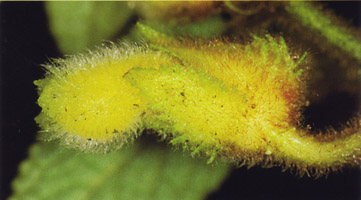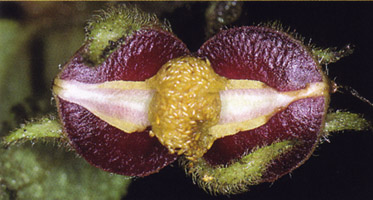
Gesneriads 56 (3): 22 (2006), phot. J.L. Clark (Ecuador)
Full name and orig. publication: Alloplectus Mart., Nov. gen. sp. pl. 3: 53, t. 223 (Jan.-June 1829).
Etymology: From the Greek άλλος, allos = diverse, and πλεκτος, plectos = pleated, folded, alluding to the calyx whose lobes are folded backwards (recurved).
Synonyms: -
Infrafamilial position: Gesnerioid Gesneriaceae (Gesnerioideae) - Episcieae.
Description: Epiphytic subshrubs with fibrous roots. Stems terete or quadrangular, usually scandent, prolifically branched. Leaves opposite, ± isophyllous, petiolate, lamina elliptic to ovate, margin entire or serrate, secondary venation inconspicuous in dry leaves. Cymes axillary, 1- to 3-flowered, bracteolate. Flowers densely crowded or solitary, non-resupinate, peduncle ± absent. Sepals nearly free, green or colored, broadly ovate, entire to strongly serrate, pubescent or pilose. Corolla oblique to horizontal in the calyx, tubular and usually ampliate, yellow or red, constricted at the throat, base gibbous, often ventricose just below the mouth, limb of usually 5 small lobes. Stamens 4, included; filaments adnate to base of corolla tube; anthers transversely oblong, coherent or becoming free, dehiscing by longitudinal slits. Nectary a 2-lobed (rarely single-lobed) gland. Ovary superior, pilose, style included. Fruit a fleshy bivalved capsule surrounded by the persistent calyx. Seeds numerous, longitudinally striate.
Chromosome number: 2n = 18.
Species number: 5.
Species names (incl. publication and synonyms): See Skog, L.E. & J.K. Boggan. 2005: World checklist of Gesneriaceae: http://persoon.si.edu/Gesneriaceae/Checklist.
Type species: Alloplectus hispidus (Kunth) Mart., typ. cons.
Distribution: From Costa Rica to the Andes of Colombia, northern Ecuador and Peru.
Ecology: Obligately epiphytic, growing in moist and wet forests, usually occurring at higher elevations (500-) 2000 - 3500 m.
Notes: The genus, having been a taxonomical wastebasket for a long time, with more than 140 species referred to it, was drastically remodelled by Wiehler (1973), and most recently - essentially based on molecular data - reduced to 5 species by J.L. Clark (see Clark 2005, 2006 and Clark et al. 2006). The remaining species have been referred to seven other genera. Characteristic features include obligate epiphytic habit, profusely branched stems, ± isophyllous leaves with inconspicuous secondary venation (at least when dry), non-resupinate flowers, corolla pouched below the mouth, longitudinally splitting anthers, and fleshy capsules . The genus is related to Glossoloma, Crantzia, Drymonia and Columnea. Possibly, no species of Alloplectus in the present restricted sense is in cultivation (Clark 2006).
Selected references: Wiehler, Phytologia 27: 309-328 (1973); Skog, Ann. Missouri Bot. Gard. 65: 793-802 (1979), reg. rev. (Panama); Feuillet & Steyermark, Fl. Venezuel. Guayana 5 (1999), reg. rev.; Skog, Monogr. Syst. Bot. Missouri Bot. Gard. 85: 1114-1128 (2001), reg. rev. (Nicaragua); Clark, Skog & Salinas, Novon 15: 70-79 (2005), new spp. (some later transferred to Glossoloma); Clark, Selbyana 25: 182-209 (2005), rev. of Alloplectus; Clark, J.L., Herendeen, P.S., Skog, L.E., Zimmer, E.A., Taxon 55: 313-336 (2006), molec. syst.; Clark, Gesneriads 56(3): 20-25 (2006), surv.
Bibliography: See Skog, L.E. & J.K. Boggan. 2005. Bibliography of the Gesneriaceae. 2nd edition: http://persoon.si.edu/Gesneriaceae/Bibliography
Illustrations:
 |
Alloplectus hispidus (Kunth) Mart., type species
Gesneriads 56 (3): 22 (2006), phot. J.L. Clark (Ecuador) |
 |
Alloplectus hispidus (Kunth) Mart., type species
Gesneriads 56 (3): 22 (2006), phot. J.L. Clark (Ecuador) |
last modified: 2007-01-05